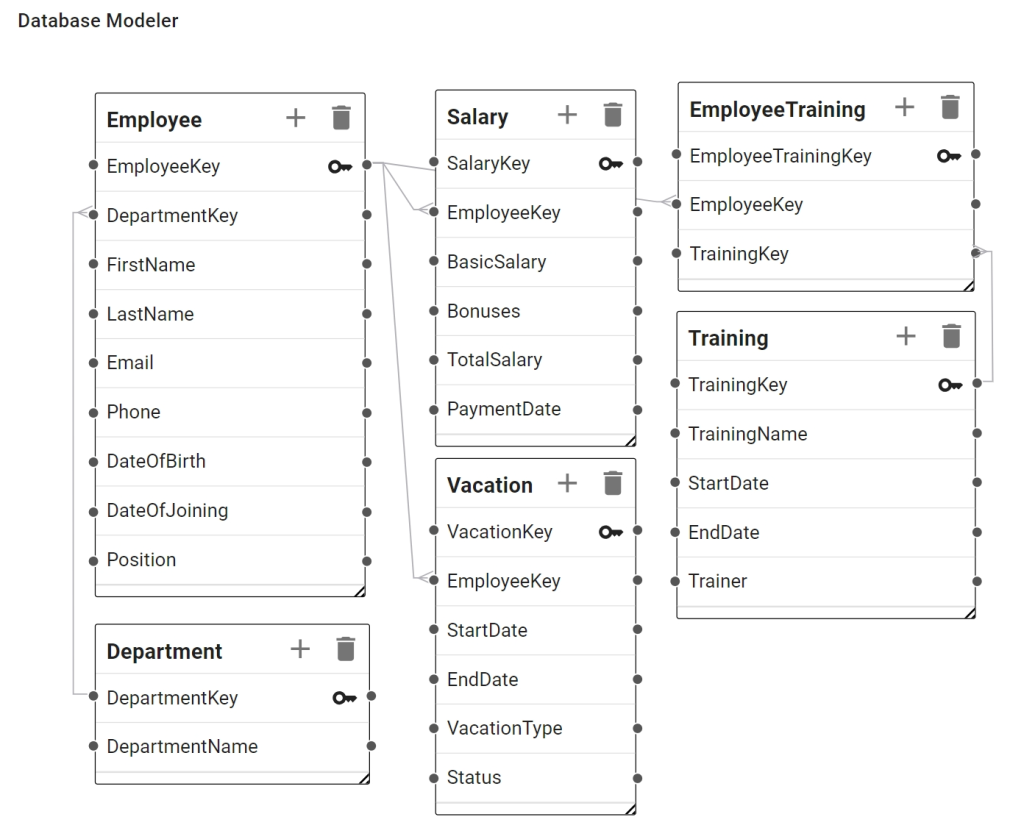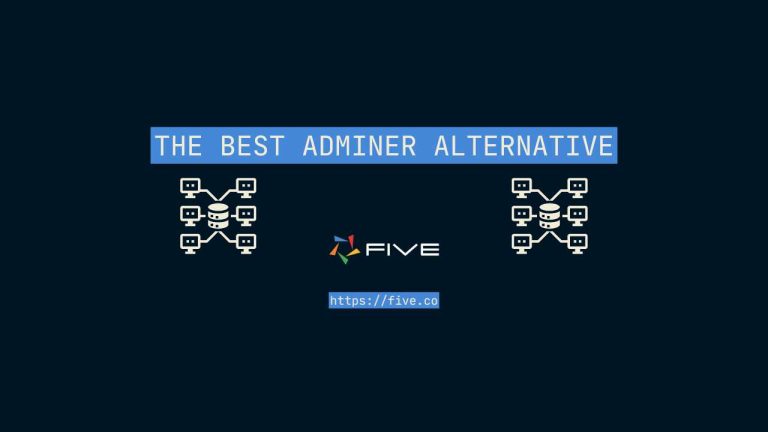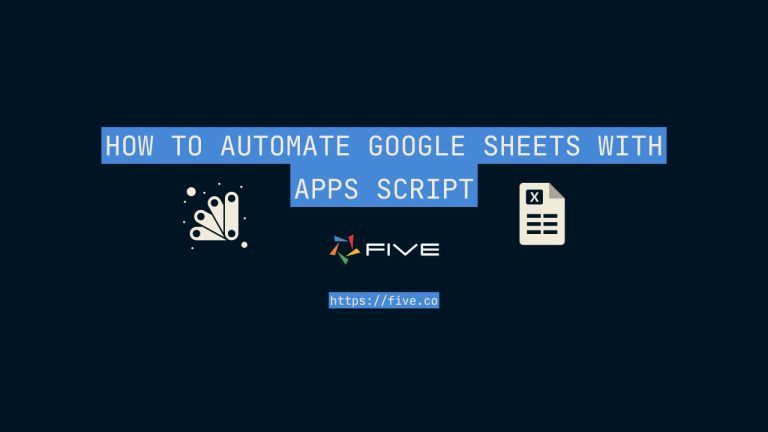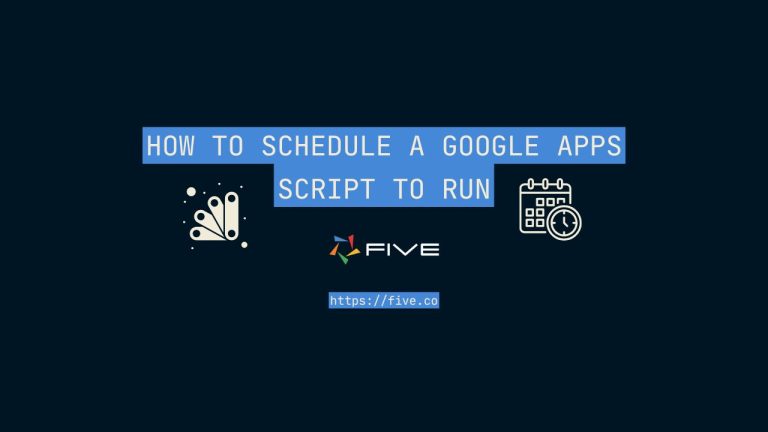Create an Employee Database In 3 Steps
A Quick Guide on How to Create an Employee Database
Employees are a business’ key resource. But especially for labor-intensive or rapidly growing businesses, it is not always easy to stay on top of human resources. Employees, departments, job titles, salaries, hierarchies, and reporting structures need to be managed, recorded, and regularly updated.
For many smaller or medium-sized businesses, human resource management starts with a simple spreadsheet solution, but as the business continues to grow, the disadvantages of spreadsheets quickly become apparent: data errors, version confusion, or multiple data all complicate human resource management.
Let’s learn how to develop an effective and secure employee database for our business in just 3 steps. Scroll down to access a template application that stores data about employees, departments, and salaries.
Why Build an Employee Database?
An employee database is crucial for businesses because it ensures that employee information is systematically organized and easily accessible. This improves the efficiency and accuracy of human resource management.
A well-structured database enhances organizational efficiency. Important questions regarding salary levels, promotions, vacations/time off, or contracts can be retrieved quickly from a single source of truth. It serves as a centralized information management tool that puts an end to double-entry errors. An employee database streamlines HR processes, such as onboarding, promotions, or management of salary bands.
A well-structured database can even support self-service capabilities. For example, it enables employees to update or enter data, relieving the HR department from the more mundane tasks of human resource management.
Last, a database is secure, scalable, and not as easily compromised or tampered with as a spreadsheet, for example. A database can be protected from unauthorized access through logins or user roles.
What Is an Employee Database?
An employee database is a digital system designed to store and manage all the information related to employees within an organization.
It includes essential data such as personal details, contact information, employment history, job roles, department affiliations, and salary information.
The purpose of an employee database is to streamline and organize employee-related data, making it easily accessible for HR management, payroll processing, performance evaluations, and strategic decision-making.
By having all employee data in a structured and unified format, organizations can efficiently track and analyze workforce metrics, ensure compliance with labor laws, and support various HR functions such as recruitment, training, and employee development.
An effective employee database enhances operational efficiency, reduces administrative overhead, and provides valuable insights that contribute to better workforce management and overall organizational success.
Employee Databases in Excel
When it is time to create a custom database, many people start with tools like Microsoft Excel or Google Sheets.
While these spreadsheet-based solutions can be convenient for smaller businesses or those who start a new business from scratch, they often lead to significant issues and are not recommended for more professional HR management.
Here are some common problems associated with using spreadsheets:
1. Security Breaches:
Spreadsheets cannot be easily secured or protected from unauthorized access. Excel or Google Sheets do not directly support user roles, authentication, or granular access control.
2. Version Confusion:
Local copies of the spreadsheet proliferate and develop a life of their own. This leads to multiple versions like “EmployeeDatabase_NEW,” “EmployeeDatabase – v2.1,” “Old Employee Database – DO NOT USE,” etc.
3. Lack of Version and Access Control:
Without clear ownership or version control, changes made by staff can be lost or duplicated, especially if the person responsible for updates leaves the company and a new person takes over.
4. Data Inconsistencies:
Comments, highlights, and manual updates lead to a cluttered and error-prone spreadsheet.
Setting up your employee database in a spreadsheet can ultimately defeat the purpose of having a single, reliable source of truth. Instead of efficient human resources management, you end up constantly fighting fires, managing and cleaning up multiple spreadsheets.
How to Create an Employee Database in 3 Steps
Building an employee database usually requires technical knowledge that someone working in HR might not have. For instance, you’d need a substantial understanding of database languages like SQL, not to mention the front-end development for user interaction.
Five is an online database builder specifically designed to make creating a customizable employee database much faster.
Creating an employee database with Five won’t be entirely effortless (but we have an employee database template available), but it will be significantly easier than spending 60+ hours learning various coding frameworks and languages. In addition, with Five, your database is fully customizable and adjustable, exactly tailored to the way you need it to run your business. Add custom fields and track whatever you wish in your employee database.
With Five, you can
1. Set up a secure database in minutes, and
2. Create a login-protected, user-friendly interface that works well on desktop, tablet or mobile.
3. You can also easily import your existing data from Excel, Google Sheets, or CSV files, allowing you to get started quickly.
Five also offers the flexibility to create custom business logic with code, generate PDF documents, and visualize your data through custom charts and dashboards.
Additionally, you can set up email notifications for your employees, ensuring your communication is seamless, standardized, and automated between you and your staff.
Get free access to Five here and start building an employee database.
Five has a team of experts ready to assist you with your development. So, if you ever feel like you’re in over your head, don’t worry, our expert developers are here to help. And yes, we promise not to charge you an arm and a leg or leave you with a system that only we understand.
To get a free consultation, visit this page: “Hire An Expert.”
Step 1: List Out Employee Attributes
Start by compiling a complete list of all attributes relevant to your employees.
Think about what matters to your human resource management and organization, such as employees’ details, join date, annual leave entitlement, salary level, or department. Your employee database should be a “single source of truth”, so ensure it’s as comprehensive as possible.
Here are some must-have attributes that are typically included in an employee database or HR system:
- Employee ID,
- First Name,
- Last Name,
- Email,
- Phone,
- Address,
- Date of Birth,
- Salary,
- Bonus, and
- Join Date.
Step 2: Define Other Important Information
Apart from storing information about your employees and who they are, your database is supposed to let you manage your human resources more effectively and reduce paperwork.
Define what documents or interactions with employees are important to your business. Different businesses, such as labor-intensive, shift-based, or remote work/gig economy businesses have different requirements and data collection needs. It’s important to map these out. Of course, it’s almost important to be aware of regulatory compliance: what records about employees must be stored and for how long?
Step 3: Creating Your Employee Database
Your list of employee attributes and other important information is ready? Great, let’s move all of this into a proper database.
To do so, sign up for Five, an online database builder that comes with a simple point-and-click interface for creating relational databases.
Follow our video tutorial to build your database tables, forms, and reports:
Employee Database: Sample Application
Here’s a employee database template application, created in just 15 minutes.
Employee Database Schema
Here’s the database schema for our application.

The employee database schema consists of several interconnected tables.
- At its heart is the employee table, storing information about employees;
- Employees are associated with a salary, department, and vacation table.
- Training stores data about ongoing training initiatives.
- Because employees can join several trainings during their career, an EmployeeTraining table exists.
With just six database tables, we have captured the key information for our employee database and human resource management software.
Each table in our database holds specific information, such as employee details, salary information, departments, job titles, training, and projects ensuring a comprehensive and organized data structure. The relationships between these tables facilitate efficient data management, enabling seamless tracking of employees, salaries, and departments.
Employee Database: Key Features
A Customizable Employee Database
We started by defining the fields (attributes) we wanted to store in our database using Five’s Table Wizard, a user-friendly, point-and-click database design tool. Add as many fields as you wish to your employee database. The database is fully customizable.
Simple-to-Use Forms
We then created the form that our users can interact with, again using just a few clicks. Forms enable us to store or retrieve information from our database.
Login Protected and Secure
Securing employee data is paramount for organizations of all sizes: Five comes with a pre-built authentication feature that adds a login screen to your application. Only registered users with valid credentials can view or edit data. You can also add multi-factor authentication for extra security.
Easily Add MFA Authentication
To further enhance the security of your database, you can add multi-factor authentication to your human resource management software.
Generate Documents
Five lets you generate documents straight from inside the application. For example, you can easily create employment contracts or annual leave forms, and build approval workflows for your documents.
Searchable and Online
Our employee database is searchable and hosted online. It can be accessed by any device and at any time.
Get Started with Five Today
To build your employee database with Five, sign up for free access and start the process. If you need assistance, visit our forum to find help from our application development experts.
By following the steps mentioned above, you can create robust and scalable employee software tailored to your business needs.



